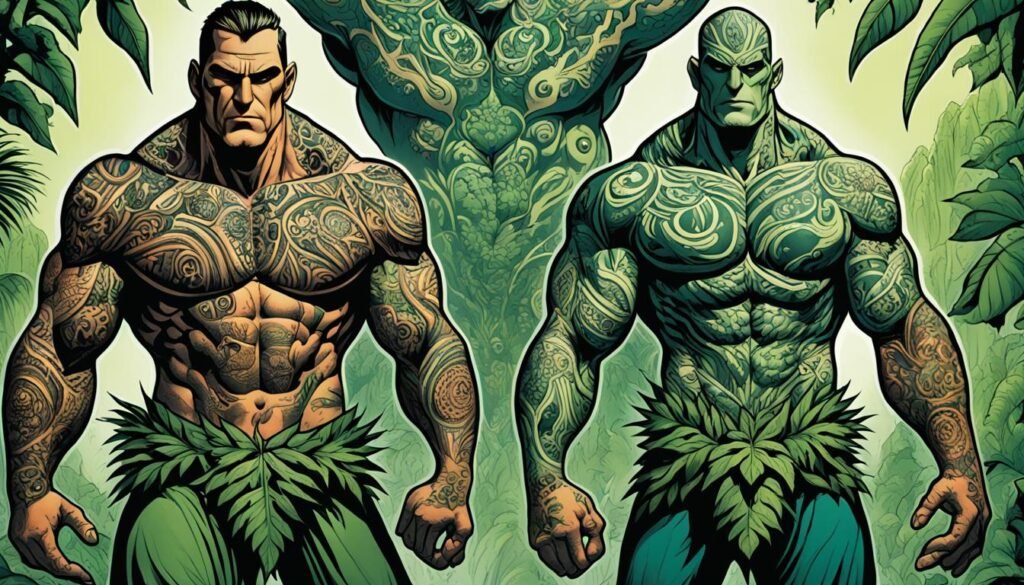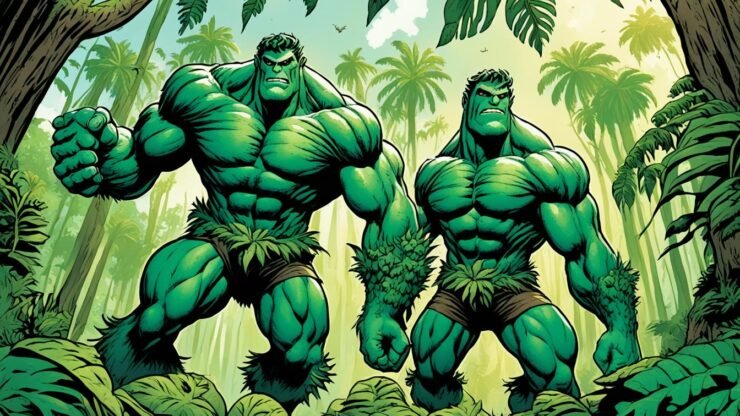In the Philippine mythology, nature and myth blend. Here, legends tell stories that captivate and awe people. Among these tales is the account of two shapeshifting giants, Kalapao and Berberoca. They are part of the Isneg people’s history. These giants can take the form of any animal, making the line between real and magical very thin.
Philippine myths are a colorful mix of stories, epics, and folklore from various native beliefs. These tales delve into the mysteries of the universe. They spotlight heroes, gods, and creatures. Kalapao and Berberoca, the giants who can change shape, are key characters in this lively world of myth.
Belonging to the Isneg group, Kalapao and Berberoca stand out for their gift to morph into animals. This ability is truly special in the Philippine myths. They are celebrated in both scholarly works and popular imagination. Their role in Isneg culture cements their place as legendary beings.
Key Takeaways
- The Philippine mythology is a rich tapestry of stories, epics, and folklore, originating from diverse indigenous folk religions and ethnic faiths.
- Kalapao and Berberoca are shapeshifting giants from the Isneg ethnic group’s mythology, known for their ability to transform into various animal forms.
- These colossal, transformative beings have become captivating figures within the broader mythological landscape of the Philippines.
- The Isneg ethnic group’s beliefs and traditions have contributed significantly to the diverse and enduring nature of Philippine mythology.
- The shapeshifting abilities of Kalapao and Berberoca highlight the fluidity and mystery that permeates the Philippine mythological realm.
Introduction to Philippine Mythology
The stories of Philippine mythology are colorful and rich. They mix various traditions like Indonesian, Malay, and more. Known as Anitism, these ancient beliefs have stood firm against time. They are still important in the Philippines.
Overview of Philippine Folk Religions
Philippine folk religions are deeply woven with tradition. Passed down through the years, they reflect the nation’s diverse culture. These beliefs have shaped the myths that the Filipino people hold dear.
Significance of Oral Traditions
Philippine myths often come from oral stories. These tales are told from one person to another, keeping the culture alive. While many stories are known, some have faded over time.
Written Sources of Philippine Mythology
Through writing, we get to learn even more about these myths. Manuscripts and other texts share the wonders of Philippine mythology. Yet, different regions’ tales may vary, adding layers to their complexity.
The Isneg Ethnic Group
The Isneg are from the northern Philippines, in Apayao. They are part of the diverse Philippine mythology. The Isneg have their own myths, stories, and figures, like Kalapao and Berberoca, who could change shape. These tales add to the colorful mythological world of the Philippines.
The Isneg people have a deep cultural history and many stories. Their myths are part of both their own culture and the larger picture of Philippine mythology. The stories of Kalapao and Berberoca give us a look into the exciting world of the country’s myths. They show how unique and strong the indigenous beliefs in the Philippines are.

In the Philippine mythological world, Kalapao and Berberoca are important. These shapeshifting giants have a big role in the Philippines’ myths. By keeping and sharing these stories, the Isneg help protect the country’s mythological heritage.
Kalapao and Berberoca: The Shapeshifting Giants
Kalapao and Berberoca are a pair of giant shapeshifters from the Isneg ethnic group’s stories. They can change into animals like birds, beasts, and even little human shapes. Isneg lore views them as powerful, mysterious beings and symbols of nature’s strength and secrecy.
Origins and Cultural Significance
In Isneg and Philippine mythology, Kalapao and Berberoca are key figures. They are deeply respected within the Isneg community. Their tales are part of the group’s cultural legacy. Their shapechanging reflects their closeness to the natural world and adds to the myths’ magic.
Abilities and Powers
Kalapao and Berberoca have incredible powers. They can change their sizes, towering as giants over landscapes or becoming smaller human-like figures. This ability, combined with their mythological and cultural importance, makes them fascinating. They still intrigue scholars, storytellers, and people today.
Other Mythical Beings of the Philippines
In the Philippines, there is a rich and diverse mythological world. It includes many mythical beings. Some beloved ones are engkantos and diwatas. They are like nature spirits but have human forms. Then, there are the scary aswangs and mangkukulams. These are shape-shifters and witches who bring bad luck. The list continues with the giant Kapres. These are tree giants and the mischievous dwendes.
Each being has its own special qualities and stories. These myths show how unique the Philippines’ cultural and mythological world is.
Engkantos and Diwatas
The engkantos and diwatas are close to nature, so they are linked to certain places like forests. They are known to help and also hurt those who disturb their homes.
Aswangs and Mangkukulams
On the darker side of myths, we have the aswangs and mangkukulams. Aswangs are creepy creatures that eat humans. Mangkukulams are witches who cast harmful spells. They are seen as serious threats.
Kapres and Dwarves
The Kapres are huge, strong tree-dwelling creatures. They guard the forests in Philippine tales. Then, we have the dwendes. These are small, playful dwarves. They sometimes mix in human business with their tricks.
From loving engkantos and diwatas, to scary aswangs and powerful Kapres, and even the dwendes, each adds to the Philippines’ rich mythological tapestry. They show the vast array of stories in the country’s cultural history.

The Role of Giants in Philippine Mythology
Giants are key characters in Philippine mythology. They stand for the power of nature, showing its wildness. Giants like Kalapao and Berberoca are symbols of the earth’s vastness and wild beauty. They can change into different animals, showing how myth blends human, divine, and natural worlds.
Representation of Nature’s Might
In Philippine stories, giants represent the power behind our world. Kalapao and Berberoca, with their immense size, show the might of nature. These tales teach us to always respect the order of nature.
Symbolic Significance in Folklore
Philippine giants are more than strong, big beings. They represent ideas of wisdom, strength, and our connection to nature. Their ability to change shapes adds to the mythical world’s mystery and mixing of human and divine.
Parallels in Other Mythologies
Kalapao and Berberoca, the shapeshifting giants, are from Philippine tales. They share a lot in common with figures from mythologies worldwide. In Greek mythology, the Titans were powerful and could change form. Norse mythology also had shape-shifting beings, the giants.
These stories from different parts of the world show us something. They suggest that the idea of giants with special powers appears across many mythologies. Giants often represent a connection between the extraordinary and the natural world.
Similarities with Greek and Norse Giants
Kalapao and Berberoca, like the Titans and jötunn, show a common interest. They show how mythologies often depict beings who are huge and can change their shape. This reflects a theme about big ideas, change, and the unknown in nature and the universe.

Preservation of Philippine Mythology
Preserving Philippine mythology is crucial to retain the nation’s rich cultural heritage. Overcoming hurdles like colonization and modernization is tough. Still, efforts to document and share these legends are ongoing.
With the help of scholars and cultural institutions, interest in Philippine myth has grown. Books, research, and programs are happening. They bring to light stories of beings like Kalapao and Berberoca, teaching us about the Philippines’ deep traditional beliefs.
Importance of Cultural Heritage
Preserving Philippine myth is key for the country’s cultural heritage. These stories, with figures like Kalapao and Berberoca, connect the Philippines to its indigenous roots. They show how the nation’s faith has stood strong against changing times.
Initiatives and Efforts
Many initiatives and efforts are made for preserving Philippine mythology. There’s scholarly work, research, and teaching programs. These initiatives deepen our understanding and love for these stories. They make sure legends like Kalapao and Berberoca are remembered and cherished by future generations.
Adapting Myths for Modern Storytelling
As our world changes, the myths of the Philippines evolve too. The stories of shapeshifters like Kalapao and Berberoca are being told in new ways. Authors, artists, and storytellers are bringing these traditional tales to modern times. They use books, movies, and the internet to share them widely.
These new versions of old stories are helping Philippine myths reach people worldwide. They are keeping the tales alive, interesting even young readers. By mixing old myths with today’s viewpoints, they keep Philippine culture strong. They encourage everyone, young and old, to learn about their rich mythical past.

| Adaptation Approach | Examples | Impact |
|---|---|---|
| Literature | Novels, short stories, and poetry that reinterpret traditional Philippine myths | This introduces the stories to a wide readership. It helps people understand Philippine myths and culture better. |
| Film and TV | Cinematic adaptations that put mythical creatures on screen | These adaptations capture viewers worldwide. They help to keep the rich mythical tales of the Philippines known and appreciated. |
| Digital Media | Games, cartoons, and online content about Philippine myths | They catch the interest of young people. They make the old stories fun and easy to find online. |
By sharing Philippine myths through modern stories, creators are doing something very important. They share these ageless tales with a big audience. They make the stories stay meaningful today. Their work shows how important the mythological heritage of the Philippines is.
The Enduring Legacy of Kalapao and Berberoca
The shapeshifting giants, Kalapao and Berberoca, made a big impact on the Philippines’ myths. They are key figures for the Isneg ethnic group’s belief system. These big, changing beings are still very interesting to scholars, artists, and everyone. Their power to change and their strong ties to nature mean a lot to the Isneg people. They show the deep stories and strength of the Philippines’ myths.
Kalapao and Berberoca show how rich Philippine myths are. As giants who can change shape, they attract many people’s imagination. They can become any animal and are deeply linked to the natural world. This shows their power and mystery, which are key in Philippine mythology. Even as time goes on, these giants stay important, showing how strong and full of stories the country is.
Conclusion
Kalapao and Berberoca are giants who can change shape. They are special in the Philippine myths. They come from the Isneg people’s stories. These giants show the power and mystery of nature by turning into animals. They are key characters in the Philippine mythical world.
The tales about these giants are kept alive in many ways. With academic studies and new retellings, their stories live on. This helps keep the spirit of Philippine mythology alive in the country’s culture. Even as times change, their tales find new ways to engage people. They still have a strong impact on Filipino culture today.
The story of Kalapao and Berberoca is more than just a myth. It shows the strength and change of Philippine myths over time. These giants have a lasting place in the hearts of the Filipino people. They act as a link between the past, present, and future. It shows how stories can connect us in meaningful ways.

